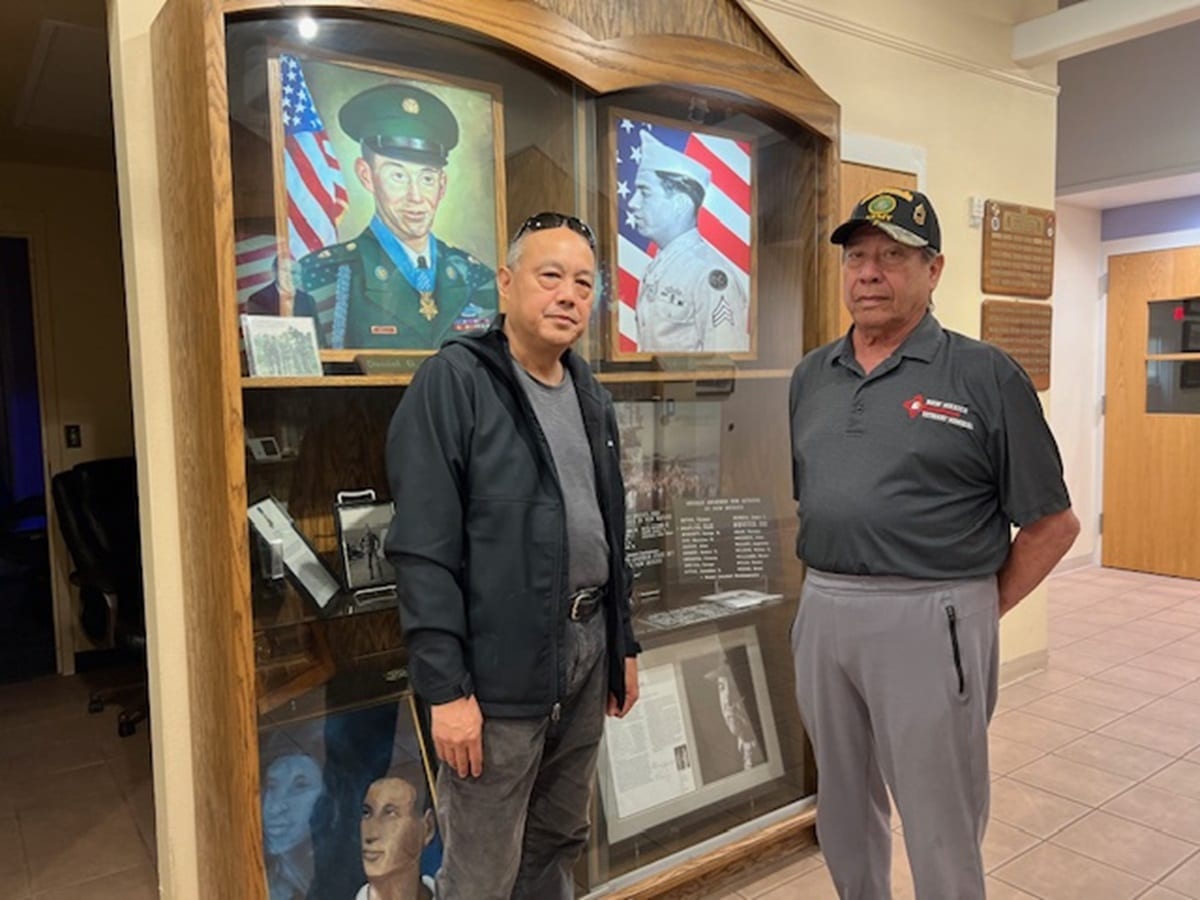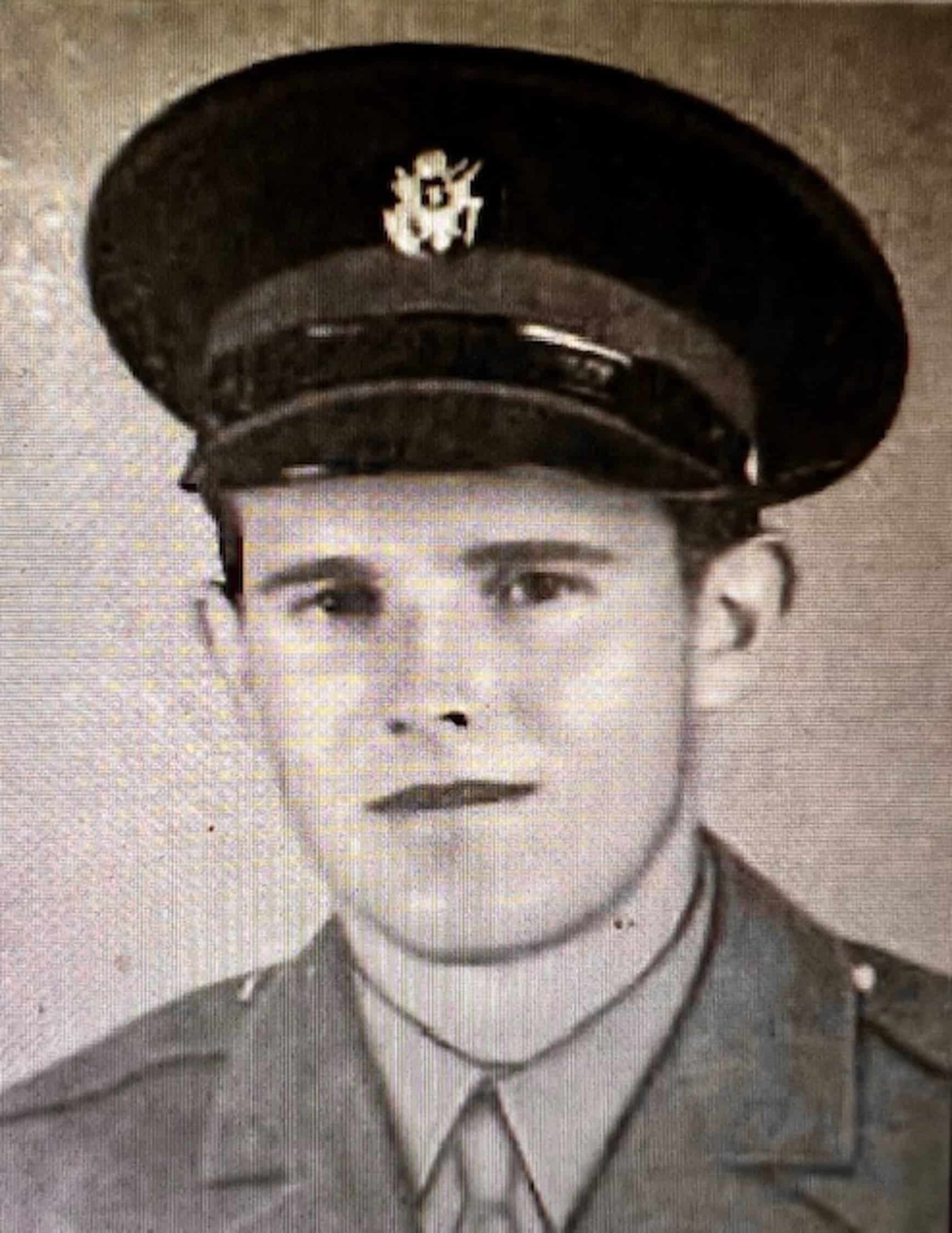Stealing MacArthur’s thunder

FORGOTTEN Curator Richard Kozlowski (right), with the author, is not happy to find that US Army Pvt. Harold H. Moon Jr., a hero in the Battle of Leyte 80 years ago, is not at the New Mexico Veterans Memorial. —Danny Petilla
(First of two parts)
ALBUQUERQUE, NEW MEXICO, United States — In an old cemetery here where America buries its war dead, one grave site stands out among rows and rows of gray tombstones richly carpeted in green grass.
A five-pointed gold star atop the name of Harold H. Moon Jr. tells visitors to this century-old cemetery that he is no ordinary casualty of war.
“He is the only American soldier buried here who received the Medal of Honor (MOH). And we have 90,000 souls resting here,” said Marilyn Fehrmann, the records keeper at Sunset Memorial Park along Menaul Boulevard.
READ: PH wartime heroes get honors from US
The MOH is America’s highest military award given only to a chosen few for heroic acts in times of war. To date, only 3,519 soldiers have received the award since the president—through Congress—started giving it in 1862, according to the MOH official website.
“Moon is one of our own. A native son who went to fight a war in a foreign land and came home a hero,” said Isaiah Atencio, the cemetery groundskeeper, as he unloaded a wheelbarrow full of fresh Kentucky bluegrass on a nearby grave.

‘UNFORGETTABLE’ Pvt. Harold Moon Jr., the lowly soldier who stole General MacArthur’s thunder during the Leyte Landing 80 years ago. —Medal of Honor Website
Respect, remembrance
That foreign land is this reporter’s homeland, the Philippines, where 80 years ago this Sunday, thousands of American soldiers headed by Gen. Douglas MacArthur stormed the beaches of Leyte, keeping his “I shall return” promise to liberate the Philippines from almost three years of brutal Japanese occupation.
As part of the 24th Infantry Division of the US Army, 23-year-old Private Moon came with the fifth wave around noon on that fateful Friday of Oct. 20, 1944.
By dawn the next day, Private Moon was dead, a victim of a banzai suicide attack by a platoon of bayonet-charging soldiers from the dreaded 16th Japanese Imperial Army who had brought death and destruction to Manchuria and Bataan.
Armed with a bottle of Brasso metal polish, I had been given permission by this kindly groundskeeper to clean Private Moon’s bronze tombstone, now gathering grime in the early autumn sun.
It is a small gesture of respect and remembrance for a soldier who was martyred in a small village in my hometown, fighting for freedom and defending my country from foreign invaders.
The only other time I had to polish the tomb of a dead soldier is whenever I visit my father, Ignacio, at Riverside Veteran’s Cemetery in California.
Answering the call of MacArthur to defend their homeland, my father joined the war effort in 1944, digging ditches and building housing for the US military in Okinawa, Japan.

LEFT BEHIND Pvt. Bienvenido Petilla, the author’s uncle, one of the prisoners of war held by the Japanese when MacArthur fled the Philippines in 1942, died in a prison camp after surviving the Bataan Death March. —Family photo
Father’s stories
Two years earlier, on May 24, 1942, my father’s older brother Bienvenido died from malaria and dysentery. While he survived the Bataan Death March from April 9 until April 17 that year, my uncle—our beloved Tatay Benido—perished with some 17,000 other US and Filipino prisoners of war from that brutal march.
My grandmother Sulpicia received a monthly $45 pension, a small token of America’s gratitude for my uncle’s sacrifice.
As a teenager growing up in the 1970s, I had faint memories of my father’s stories about a brave American soldier who killed scores of Japanese soldiers as the tide of the Pacific war turned in favor of the Americans in 1944.
My fascination for this unnamed soldier grew and in 1984, after I got my journalism degree from the University of Santo Tomas, I visited my hometown of Palo, Leyte, in time for the 40th anniversary of the Leyte Landing.
Returning to their former field of battle, aging American veterans of that historic landing—most of them in their late 60s—distributed a newsletter to the locals. It was on the pages of Taro Leaf magazine given to me by former Palo Mayor Cornelio Montejo Sr. that I first learned about the identity and gallantry of Private Moon.
My father’s story about this swashbuckling American was no tall tale after all.
Forty years later—in the present day, when the wars in Ukraine and in the Middle East threaten another global conflagration—the legend of Private Moon still mystifies me and his bravery lingers like an old refrain.
To satisfy this curious quest, I hopped on the Amtrak Southwest Train No. 4 from Union Station in Los Angeles on Sept. 22, the first day of autumn in North America, to take the 1,200-kilometer journey to this city in the American southwest.
From my train window, I amused myself along the way with hauntingly long stretches of golden desert from California, Arizona and here in New Mexico where the world’s first atomic bomb was detonated on July 16, 1945.
‘A travesty!’
Driving in my rented Jeep Grand Cherokee along Central Avenue near the University of New Mexico in Albuquerque, I was gratified to see Moon Avenue.
“At least there is a street named after him,” I muttered to myself.
How disappointed was I to learn the next day that that street was not named for Moon, the war hero, but for a politician from the 1930s, state Sen. Z. B. Moon.
“This is a travesty! He was born here and his image is nowhere to be found,” said Richard Kozlowski, a curator at Albuquerque’s sprawling 10-hectare New Mexico Veterans Memorial.
“Maybe it’s the passage of time. It’s been too long, so he is unknown to us,” Dr. Allen Dale Olson, secretary of the Museum of the American Military Family, told me over the phone.
Private Moon, New Mexico’s first MOH recipient, is all but forgotten in the land of his birth.
“Make sure you tell this story and we will tell our politicians here what they have missed,” said Kozlowski, an 83-year-old Vietnam veteran.
Of the nine posthumously awarded with the MOH here in New Mexico, only Private Moon is not named for a military base, a school, a navy ship, a post office or even a local veterans’ chapter.
“Harold Moon was almost drummed out of the Army,” wrote local military historian John Taylor in his 2023 book “A Legacy of Heroism.”
“But when his platoon recovered his body they found 200 enemy soldiers within 100 yards of his foxhole,” Taylor wrote.
In the heady days of October 1944, as Filipinos swooned in adulation of their liberator MacArthur, the legend of Private Moon will slowly rise as the fog of war clears.
(To be concluded: General MacArthur and Private Moon both were awarded the Medal of Honor, both also share a common trait: defying their superiors.)